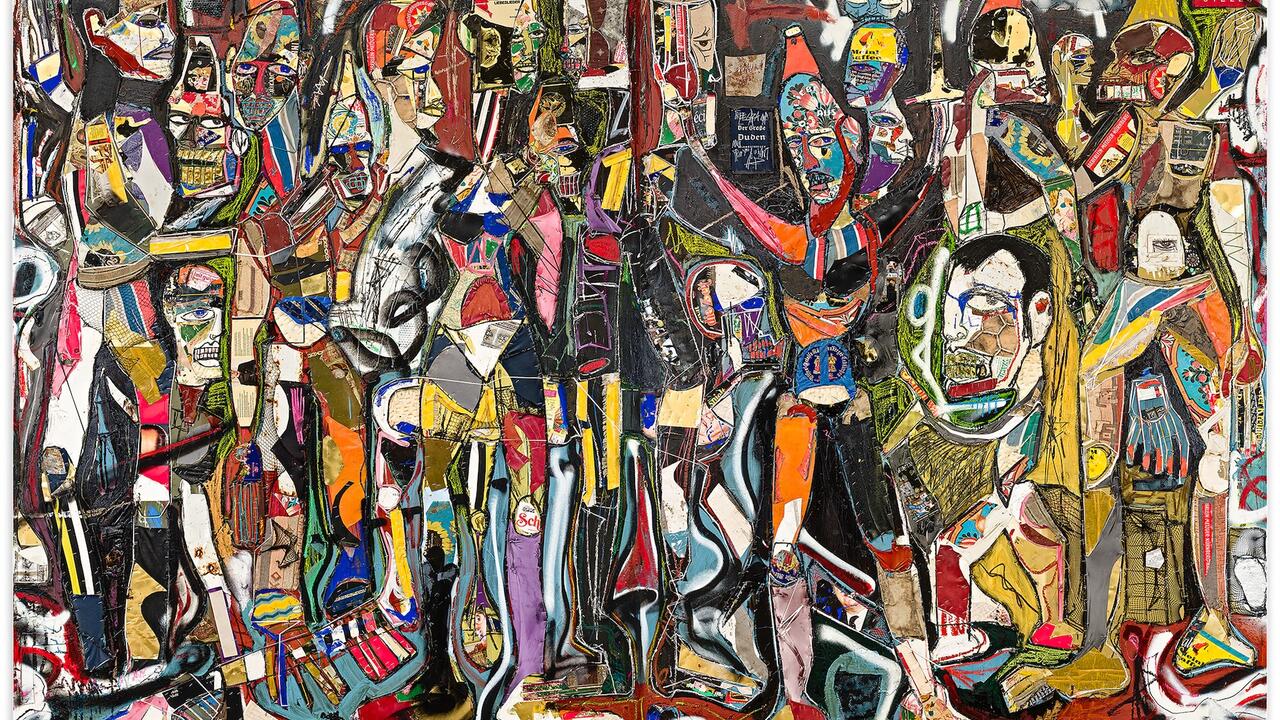Raymond Hains
Galerie Max Hetzler, Berlin, Germany
Galerie Max Hetzler, Berlin, Germany

Tacita Dean once described meeting Raymond Hains in Paris and his famously associative way of talking: ‘Hains cannot be interrupted in the direction his unconscious journey is taking,’ she wrote. ‘He is a true follower of objective chance.’ The scale and velocity of this ‘unconscious journey’ is felt in the comprehensive exhibition of Hains’s work at Max Hetzler’s two galleries in Berlin and his Paris outpost. The three exhibitions are organized loosely thematically: ‘Raymond la science’ (Raymond the Science), examines the artist’s experimental approach; ‘Raymond l’abstrait’ (Raymond the Abstract), in the larger Berlin space, looks at his associative logic; while ‘Raymond le disert’ (Raymond the Talkative), in Paris, takes language as its cue. Beginning with tiny black and white photographs shot in 1944, which documented the war-ravaged streets of his hometown, St Malo et Dinard, Brittany, and concluding with a series of geometric neons based on Borromean knots by Jacques Lacan, Hains seems barely to have paused for breath during his six-decade career, until his death in 2005.
A trio of pieces in the more intimate of the Berlin galleries manifests the fluid metamorphosis of his work throughout his long career. Pénélope (1950–54), a small gouache composed of wobbly lozenges of red, blue and white, was derived from an abstract film he made with fellow artist Jacques Villeglé, shot with a self-made distortion machine he called a hypnagogoscope: a camera with a lens of fluted glass. This pattern (which recurs throughout Hains’s work) also appears on a parasol shading a white plastic table and chairs (Parasol, 2004). Finally, Palissade CIC (2001), a wall panel of blue Plexiglas strips, incorporates a number of small videos into its surface, documenting the artist at work, talking with friends at streetside cafes, or walking along the beach, always with his camera strung around his neck. A self-portrait of sorts, it introduces Hains as an insatiable documenter of the vagaries of everyday life – a tendency illustrated in the exhibition’s last room, which exhumes two of the many hundreds of archival boxes in which Hains collected and stored assorted ephemera, and displayed their contents: notebooks dense with handwriting, boxes of slides, postcards and guidebooks. The contents of these archival boxes – like situationist versions of Andy Warhol’s time capsules guided by the principles of dérive – are like an art historian’s dream.
Hains is most often associated with Pierre Restany’s nouveau réalisme movement, which sought to shift from the world of painting to ‘truth in the world’. His affichist works – torn advertising posters taken from hoardings, which he began making in 1949 – as well as the ‘pallisades’ – rearrangements of fence boards – remain his most striking pieces. Combining accident with haptic appeal, they demonstrate Hains’s claim to be an ‘inaction painter’: ‘I’m not so much a creator, encounters are more my thing.’ At the same time, they update the readymade for a proto-pop era of consumerism. Works such as Untitled (1971), in which the word ‘révolution’ is partially visible, bring up associations with the political climate of Paris ’68, while the impressive large-scale nonchalance of his affichist works appears effortlessly contemporary, bringing to mind all manner of younger artists from Klara Lidén to Michel Majerus to Sterling Ruby.
But, as this exhibition demonstrates, nouveau réalisme was just one facet of his practice. A suite of five untitled photograms from 1946–47 of tiny abstract grids, forms and objects, suggests the start of an enquiry into the nature of perception. Around this time, Hains began experiments with lenticular glass that led to the creation of the hypnagogoscope. Two black and white distorted photographs dated 1948–89 are printed large and mounted on aluminium, suggesting his constant reuse and updating of his personal archive, adapting the means of presentation to fit the time.
Though associated with surrealism and pop, Hains’s work was too restless to sit comfortably in any one category. The pieces in the second Berlin show convey this, beginning with a graphically skewed clock face from the hypnagogic phase, and a signature sculptural ‘matchbox’, while including more incidental works such as Stella deformé (Deformed Stella, 1989), a photograph juxtaposing a catalogue on Frank Stella with a glass of Stella Artois. In the back of the gallery, this associative wordplay transitions to the digital world, in a large-scale screenshot showing three cross-linked open windows, one of the ‘Macintoshages’ he began making in 1998. Though it may appear clumsy and quaint by today’s post-internet standards, it is nonetheless evidence of Hains’s readiness to adapt to the tools of the time, despite his pushing 80 when this work was made. These exhibitions are a tantalizing hint of the breadth of Hains’s approach and the constantly nimble state of his free-associative mind. They left me wanting to see more.






















